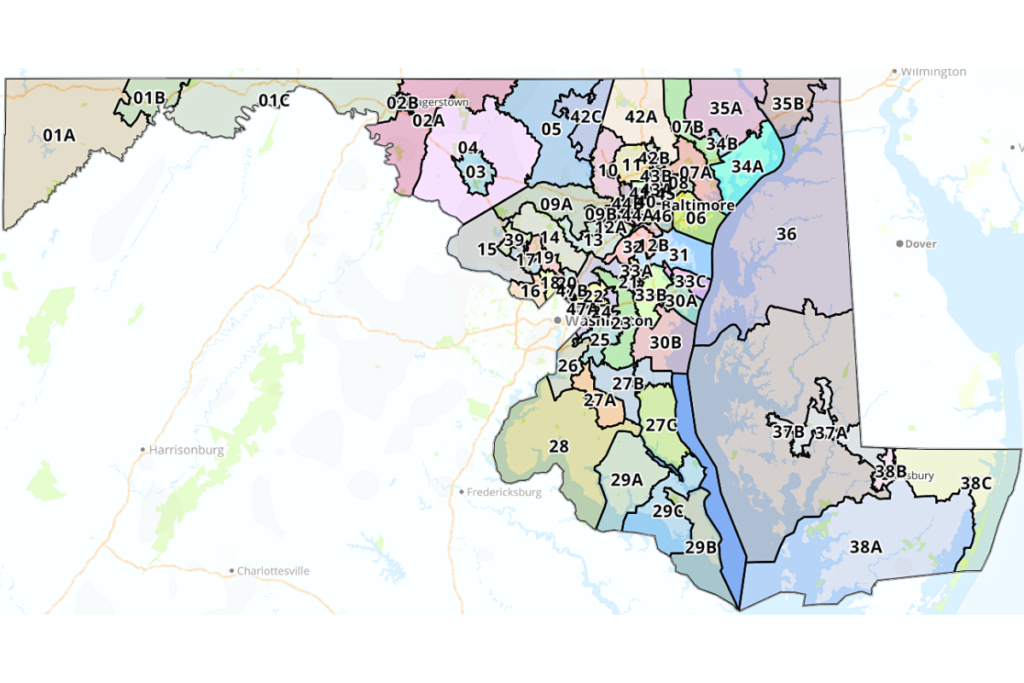This article was republished with permission from WTOP’s news partners at Maryland Matters. Sign up for Maryland Matters’ free email subscription today.
This content was republished with permission from WTOP’s news partners at Maryland Matters. Sign up for Maryland Matters’ free email subscription today.
The Maryland Legislative Redistricting Advisory Commission released a proposed legislative redistricting plan Monday evening that would further erode the political power of Baltimore City, shore up vulnerable Democrats, and create a few opportunities for Democrats to go on offense — even though they already hold supermajorities in both the House of Delegates and Senate.
The plan, which is available online, will be up for a virtual public hearing at 4 p.m. Wednesday.
While data on the partisan makeup of the proposed state Senate and House of Delegates redistricting plan wasn’t immediately available Monday night, the map envisions several key changes to the current boundaries, including:
- Just four full state Senate districts would be wholly within Baltimore City, while a fifth district based in the city, 43, would run north into Baltimore County to include the area around Towson. The city lost population over the last decade, and currently contains five full state Senate districts and a portion of District 44, which includes parts of Baltimore County’s southwestern peninsula around Woodlawn and Lochearn.
- That shift would essentially turn District 42A, represented by Del. Catherine M. Forbes (D-Baltimore County), into District 43B. District 43, represented by Sen. Mary L. Washington (D-Baltimore City), would include several major higher education institutions like Johns Hopkins University, Loyola University, Goucher College and Towson University.
- District 9A, which currently includes roughly the northwestern half of Howard County and part of southern Carroll County, would lose Carroll County and instead include part of northern Montgomery County, potentially shoring up Sen. Katie Fry Hester (D-Howard) for reelection.
Montgomery County retains eight state Senate districts in addition to gaining part of District 9. - The city of Frederick would remain contained within District 3, which would become a strong Democratic multi-member district that would be encircled by the Republican-leaning multi-member District 4.
- Prince George’s County’s District 47B, currently the state’s only majority-Latino subdistrict, appears to remain intact in the Legislative Redistricting Advisory Commission proposal. Advocates urged members of the commission to maintain that district at their first public hearing in September. Prince George’s County’s District 23, centered around Bowie, would become a multi-member district rather than being split into two subdistricts. That would appear to spell trouble for Del. Geraldine Valentino-Smith (D).
- Anne Arundel County’s District 33, which is currently a purplish district represented by Republican Sen. Edward R. Reilly, would be chopped into three subdistricts and become more favorable to Democrats. District 33A as proposed seems likely to elect a Democrat — possibly Anne Arundel County Councilmember Andrew Pruski, who has expressed interest in running for the House. District 33C, where Del. Heather A. Bagnall (D) lives, appears to be a tossup district. She won a District 33 seat in an upset in 2018.
- In Baltimore County, District 8, traditionally a competitive district, appears to have become more Democratic, while District 42, which leans Republican, appears to have become more conservative. However, as proposed in the new map, a subdistrict, 42B, could shore up Del. Michele Guyton (D).
Democrats currently hold a 32-15 majority in the state Senate and a 99-42 advantage in the House of Delegates.

The Legislative Redistricting Advisory Commission was created by Senate President Bill Ferguson (D-Baltimore City) and House Speaker Adrienne A. Jones (D-Baltimore County). Jones and Ferguson both sit on that commission, alongside Senate President Pro Tem Melony G. Griffith (D-Prince George’s), House Majority Leader Eric G. Luedtke (D-Montgomery), House Minority Leader Jason C. Buckel (R-Allegany) and Senate Minority Leader Bryan W. Simonaire (R-Anne Arundel).
That commission is chaired by Karl Aro, a former head of the nonpartisan Department of Legislative Services.
The General Assembly is set to tackle legislative redistricting when lawmakers return for their regular session in January. Democratic lawmakers passed a congressional redistricting proposal during a special session in December, overriding a veto from Gov. Lawrence J. Hogan Jr. (R). Constitutionally, Hogan can’t veto the General Assembly’s legislative maps, but his proposed maps become law if the General Assembly doesn’t pick an alternative within the first half of the 2022 legislative session.
Hogan created the multi-partisan Maryland Citizens Redistricting Commission via executive order to draw up congressional and legislative maps. That panel’s congressional proposal didn’t make it out of committee during the special session in December, although Republican lawmakers unsuccessfully attempted to amend the Legislative Redistricting Advisory Commission’s congressional proposal to substitute the Maryland Citizens Redistricting Commission’s maps.
Maryland’s state constitution allows for a mix of single- and multi-member delegate districts, which are in turn required to be nested within state Senate districts. In his executive order creating the Citizens Redistricting Commission earlier this year, Hogan said single-member delegate districts should be used in the map “to the extent possible.” After weeks of debate, panelists decided to use a mix of single- and multi-member districts based generally on population density.
Like the state’s current legislative map, the Legislative Redistricting Advisory Commission’s proposal uses a mix of single- and multi-member districts, although it doesn’t follow a set formula.
Doug Mayer, a former Hogan communications strategist and spokesperson for the Hogan-aligned anti-gerrymandering group Fair Maps Maryland, criticized the redistricting proposal from the Legislative Redistricting Advisory Commission in a statement Monday, and took particular issue with the configuration of multi-member and single-member districts in the newly released map.
“Some voters have one delegate, some have two and some have three – that’s not equal representation,” Mayer wrote, “That’s electoral corruption. We look forward to seeing the folks who created these monstrosities publicly defend them under the bright lights of the Senate and House chambers.”
Jones previously defended the state’s mix of single- and multi-member districts, saying it has led to diverse and reflective representation in Maryland; the General Assembly outpaces other states legislatures in gender and racial diversity.
“The Maryland Constitution specifically provides for both single and multimember districts,” Jones said in August. “It’s a unique system that has made our House of Delegates one of the most diverse legislative bodies in the country. It also provides for diversity of thought, sometimes electing both Republicans and Democrats to the House from the same district. It may not fit the partisan goals of some but I think it provides voters with more choices while balancing the need for community representation.”
Josh Kurtz contributed to this report.







